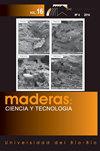Evaluation of bean residues in the production of agglomerated panels
IF 1.5
4区 农林科学
Q3 MATERIALS SCIENCE, PAPER & WOOD
引用次数: 2
Abstract
This work aimed to evaluate the physical-mechanical properties of Pinus oocarpa wood agglomerated panels produced with different levels (0 %, 25 %, 50 %, 75 % and 100 %) of wood replacement with bean residues. For this purpose, Pinus oocarpa wood and the agricultural residue were reduced into particles and their properties of apparent density, extractives, lignin and ash content of these raw materials were determined. Then, the particles were dried to a 3 % humidity and granulometrically selected to produce panels with a den - sity of 0,60 g/cm 3 . These particles were bonded using 12 % urea-formaldehyde adhesive, pressed, following normative dimensions (250 mm x 250 mm x 15 mm (width, length, and thickness)), and kept in a climate-con - trolled environment (20 ºC ± 2 ºC and 65 % ± 5 % RH) until the physical and mechanical tests were carried out. The research results indicated that the particles from bean residues in comparison with Pinus oocarpa wood, presented low density, lignin and holocellulose values, and higher extractives data. Furthermore, regarding the characterization of the panels, there was a trend towards uniformity in the apparent density values, an increase in the properties of compact ratio, water absorption and thickness swelling, and a decrease in their mechanical properties associated with the increase in the by-product addition to the panels. Therefore, new studies are necessary, seeking a larger study and greater knowledge of the addition effects of bean residues in particulate panels, aiming the dissemination of this sustainable process on large scale.聚块板生产中豆渣的评价
这项工作旨在评估不同水平(0%、25%、50%、75%和100%)的大豆残留物木材替代生产的松木胶合板的物理力学性能。为此,将松木和农用残渣还原成颗粒,并测定了这些原料的表观密度、萃取物、木质素和灰分含量等特性。然后,将颗粒干燥到3%的湿度,并按粒度选择生产密度为0.60 g/ cm3的面板。这些颗粒使用12%脲醛粘合剂粘合,按标准尺寸(250 mm x 250 mm x 15 mm(宽度,长度和厚度))压制,并在气候控制的环境中保存(20ºC±2ºC和65%±5% RH),直到进行物理和机械测试。研究结果表明,与松木相比,豆渣颗粒具有密度低、木质素和纤维素含量低、提取率高的特点。此外,在表征方面,随着副产物添加量的增加,面板的表观密度值趋于均匀,压实比、吸水率和厚度膨胀性能增加,其力学性能下降。因此,有必要进行新的研究,寻求更大规模的研究和更深入的了解豆类残留物在颗粒板中的添加效应,旨在大规模推广这一可持续过程。
本文章由计算机程序翻译,如有差异,请以英文原文为准。
求助全文
约1分钟内获得全文
求助全文
来源期刊

Maderas-ciencia Y Tecnologia
工程技术-材料科学:纸与木材
CiteScore
2.60
自引率
13.30%
发文量
33
审稿时长
>12 weeks
期刊介绍:
Maderas-Cienc Tecnol publishes inedits and original research articles in Spanish and English. The contributions for their publication should be unpublished and the journal is reserved all the rights of reproduction of the content of the same ones. All the articles are subjected to evaluation to the Publishing Committee or external consultants. At least two reviewers under double blind system. Previous acceptance of the Publishing Committee, summaries of thesis of Magíster and Doctorate are also published, technical opinions, revision of books and reports of congresses, related with the Science and the Technology of the Wood. The journal have not articles processing and submission charges.
 求助内容:
求助内容: 应助结果提醒方式:
应助结果提醒方式:


